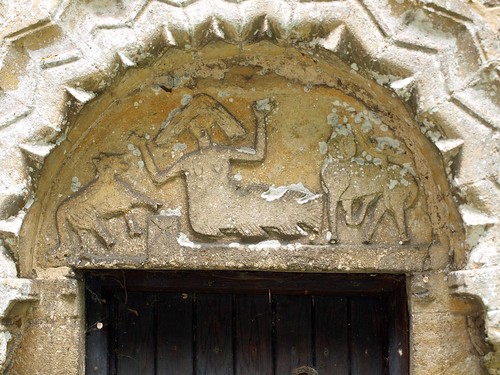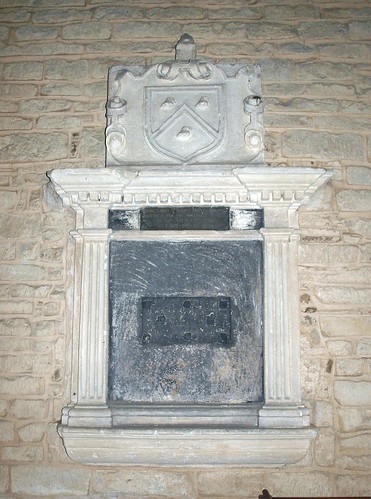ST BOTOLPH. The church is outside the village. It is quite large. The Norman tympanum of the priest’s doorway is more barbaric than almost any other. The centre is a mermaid, and l. and r. are quadrupeds. Coarse zigzag surround, wildly detailed capitals of the colonnettes below. W tower with pairs of transomed two-light bell-openings. No spire. The tower can be dated c.1500 from an inscription to Robert Becke (S wall) and the arms of Bishop Smith of Lincoln (1496-1514; W wall). E.E. S doorway with three orders of colonnettes with very damaged stiff-leaf capitals. Arch with hollow chamfers. The arcades are E.E. too, N being a little earlier than S. Four bays, round piers, double-chamfered arches, those of the S arcade with broaches. The N aisle was never widened. The aisle windows partly straight-headed Dec, partly Perp. E.E. again the chancel arch. The respond shafts start high up; there was probably a stone screen here. - FONT. Octagonal, but the round support made up of two E.E. capitals. - SCREEN. Perp, with wide one-light divisions. - REREDOS. This incorporates one panel with reticulated tracery brought in from an Oxfordshire church. - (STALL END. One, with a poppyhead. GMCH) - SOUTH DOOR. With a little tracery. - SCULPTURE. One stone with interlace, rather from a coffin lid than a cross; C11 or C12.- STAINED GLASS. Small bits in two N aisle windows. - BELL. One bell by Henry Jordan, i.e. c.1450-60. - PLATE. Paten with head of Christ engraved; hallmarked 1491-2. This is the oldest known London hallmark. - Cup of 1577-8. - MONUMENT. Tablet to Sir Thomas Maples d. 1634. Stone surround and brass indent.
LONG STOW. We heard of this village that it has a mermaid who has never seen the sea and a fox that has never heard the huntsman’s horn. We may add another and prouder distinction, for it has the oldest piece of altar plate in the county.
The fox is on a weathervane gaily turning near the green, on which stands an ancient cross. The mermaid is in the priest’s doorway leading into the chancel of the church (Syrens and demons shall dance there, and Centaurs shall take up their dwelling in their houses, says Isaiah). There is a doorway built by the Normans with simple pillars and a richly carved arch. It was the Norman mason’s fancy to put the picture of a mermaid between two terrifying beasts, her arms raised and her hands spread out as though beseeching all who come to save her, though 30 generations have left her to her fate. The old piece of altar plate is a paten, less than five inches across and engraved with a portrait of Christ; it was made about 1491.
But a treasure-house of ancient wonder is this church, tucked away down a lane for centuries. Its chancel, nave, and aisles are 13th century, its chapel 14th, and its clerestory 15th. Its Tudor tower, guarded by four gargoyles, has a 15th century bell.
The walls have two old sundials and fragments of stone with knot-work carved by Saxon sculptors. The tracery in the oak chancel screen and the stalls in the choir are 15th century. The poor-box was carved out of an oak post which helped to keep up the ancient roof for centuries. The old holy table is built into the main altar. An oak chest has iron handles and ornamental buttresses made 400 years ago, and the altar table and the reredos have carved panels three centuries old. The south doorway has three pairs of shafts and capitals carved about 1270, and in it still swings a door panelled with tracery by a carpenter of the days of Columbus.
The fox is on a weathervane gaily turning near the green, on which stands an ancient cross. The mermaid is in the priest’s doorway leading into the chancel of the church (Syrens and demons shall dance there, and Centaurs shall take up their dwelling in their houses, says Isaiah). There is a doorway built by the Normans with simple pillars and a richly carved arch. It was the Norman mason’s fancy to put the picture of a mermaid between two terrifying beasts, her arms raised and her hands spread out as though beseeching all who come to save her, though 30 generations have left her to her fate. The old piece of altar plate is a paten, less than five inches across and engraved with a portrait of Christ; it was made about 1491.
But a treasure-house of ancient wonder is this church, tucked away down a lane for centuries. Its chancel, nave, and aisles are 13th century, its chapel 14th, and its clerestory 15th. Its Tudor tower, guarded by four gargoyles, has a 15th century bell.
The walls have two old sundials and fragments of stone with knot-work carved by Saxon sculptors. The tracery in the oak chancel screen and the stalls in the choir are 15th century. The poor-box was carved out of an oak post which helped to keep up the ancient roof for centuries. The old holy table is built into the main altar. An oak chest has iron handles and ornamental buttresses made 400 years ago, and the altar table and the reredos have carved panels three centuries old. The south doorway has three pairs of shafts and capitals carved about 1270, and in it still swings a door panelled with tracery by a carpenter of the days of Columbus.



No comments:
Post a Comment